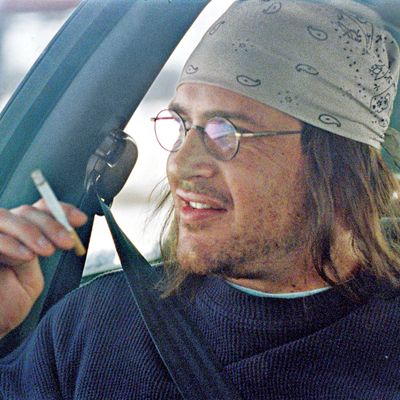
The tour in The End of the Tour is David Foster Wallace’s 1996 multicity promotion for his epic novel Infinite Jest, a fractured portrait of a manic culture and the biting loneliness at its heart. The movie, directed by James Ponsoldt from a script by the playwright Donald Margulies, depicts what happens when Wallace (Jason Segel) becomes a cog in the machine he’s attempting to deconstruct. He’s seen through the eyes of the writer David Lipsky (Jesse Eisenberg), who tags along to the last city, Minneapolis, for a Rolling Stone profile. Lipsky has just published his own novel to resounding crickets, and he oscillates between jealousy of Wallace’s sudden celebrity and a desire to live vicariously through it — to know what it’s like to be a literary sensation. Wallace, meanwhile, is visibly uncomfortable with his stardom, partly because he doesn’t want to be seen as comfortable with it and partly because he’s afraid he’ll be weakened by it existentially. He’s especially frightened of being on TV, which riveted him as a child and instilled in him the conviction that mainstream culture is evolving into an ever more efficient drug. He does, however, admit that he’d like to get laid more easily.
The End of the Tour is essentially a two-character piece in which every exchange is boldface, fraught. Wallace studies Lipsky studying him while Lipsky labors to find his story. The film doesn’t tell you that Lipsky never found it, psyching himself out to the point where he didn’t even publish the piece. But he did release an annotated transcript of the interview after Wallace’s 2008 suicide under the title Although of Course You End Up Becoming Yourself. It’s not too revealing. Wallace is controlled, self-censoring, showing little of the tempestuousness that emerges in D. T. Max’s biography Every Love Story Is a Ghost Story, let alone the philosophical daredevilry of a novelist striving to further the explorations of Thomas Pynchon and Don DeLillo. But Ponsoldt and Margulies have squeezed every last drop of subtext out of the material, and at times the movie’s small canvas feels momentous. They’ve found the inner tensions in people’s presentations of themselves in a way that’s positively Wallace-like.
Segel had me from the moment Wallace clumsily ushers Lipsky into his rural-Illinois home and says, “I feel like I should offer you tea or something.” The line means: How are we supposed to do this? His Wallace is lumbering, at a distance from his body, working to project earnestness after publicly rejecting irony as a soul-killing palliative — as well as contrary to the spirit of Alcoholics Anonymous, which likely saved his life. Segel’s delivery — with its built-in hesitation — suggests a man who’s always measuring himself against others. His self-deprecation is competitiveness redirected.
Eisenberg, by contrast, puts Lipsky’s competitiveness right on the surface. Pre–The Social Network, the actor tended to project sweetness, but playing Mark Zuckerberg opened a pipeline to his nerve endings. It takes Eisenberg’s Lipsky a long time to see past his own envy, and the questions he blurts are shallow and glib; he doesn’t seem to have understood the themes of the book he so admires. Their unacknowledged contest comes to a head when they go out with two Minneapolis blonde friends of Wallace’s played by Mamie Gummer and Mickey Sumner and, in a series of exquisitely orchestrated scenes, Wallace picks up on Lipsky’s subtle sexual moves and begins to seethe.
Not everything in The End of the Tour is so suggestive. There’s a bogus moral issue to generate suspense: Will Lipsky — following the crude dictates of the crude Rolling Stone editor — ask Wallace if he was addicted to heroin? (Big whoop if he was.) The pacing falters in the later scenes, when Lipsky and Wallace are furious at each other. But the characters remain wonderfully alive. Even at its draggiest, the film has a present-tense quality that makes you feel lucky to be in the same room as David Foster Wallace.
I can think of only one major absence: Wallace’s voice as writer. Could it have been in the movie? Sure. Wallace is shown at a bookstore about to read. (He’s anxious about lack of spit — a preoccupation in his work.) Why not let us hear something?
In 1996, I was present at Wallace’s first big event, the packed reading at K.G.B. in the East Village, wedged between bodies on the hard floor at the feet of an acquaintance, Elizabeth Wurtzel — whom Wallace greeted brightly on his way to the front and with whom he would go home that night (although her refusal to sleep with him planted the seed for the revenge story “The Depressed Person”). Anyway, he read two sections of Infinite Jest in an even, deadpan meter, the explanatory clauses spiraling out with an absurd but perfect logic, like Lewis Carroll set to Mozart. Why not show David Foster Wallace in the one arena in which he could be perfectly understood?
*This article appears in the July 27, 2015 issue of New York Magazine.


